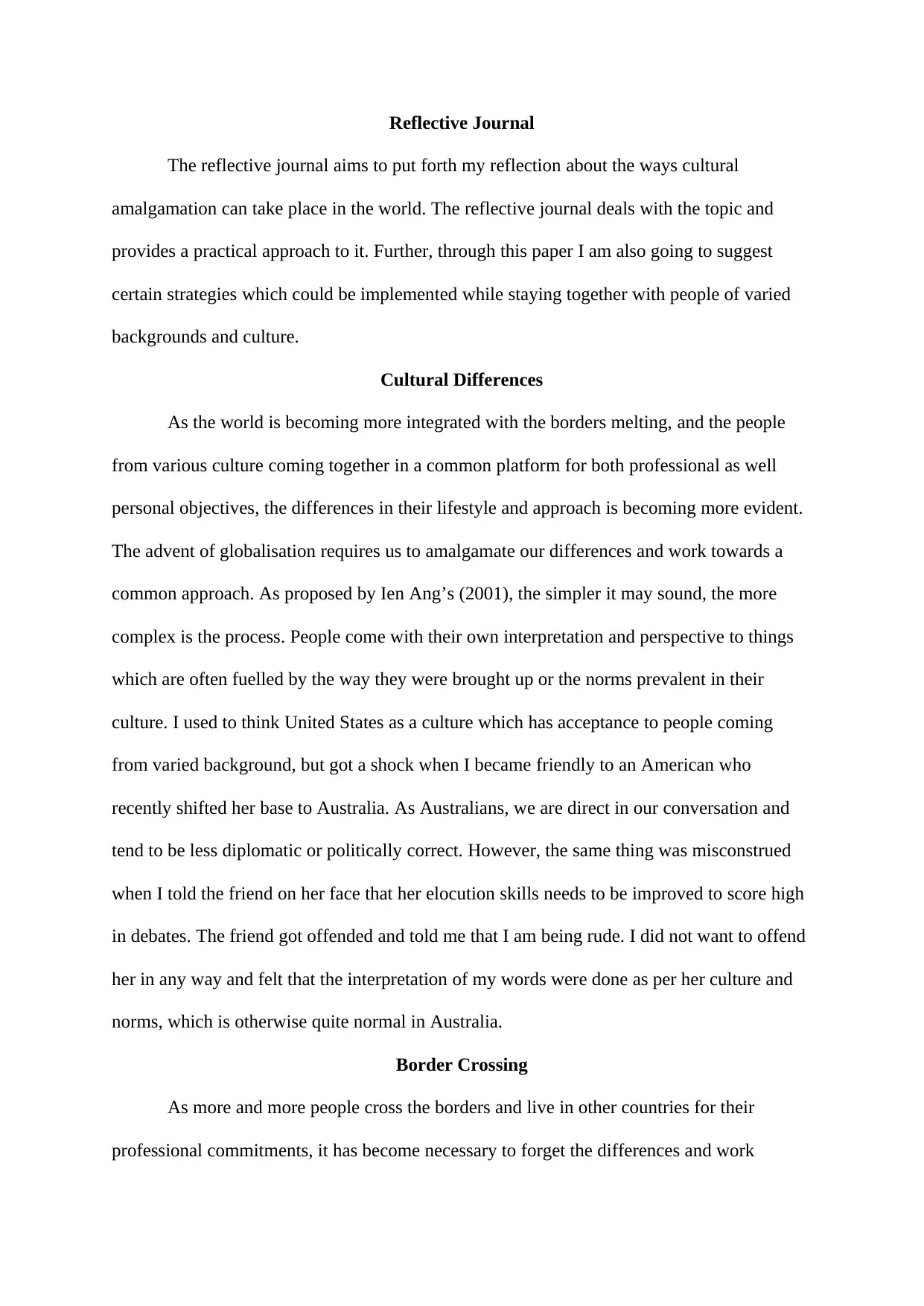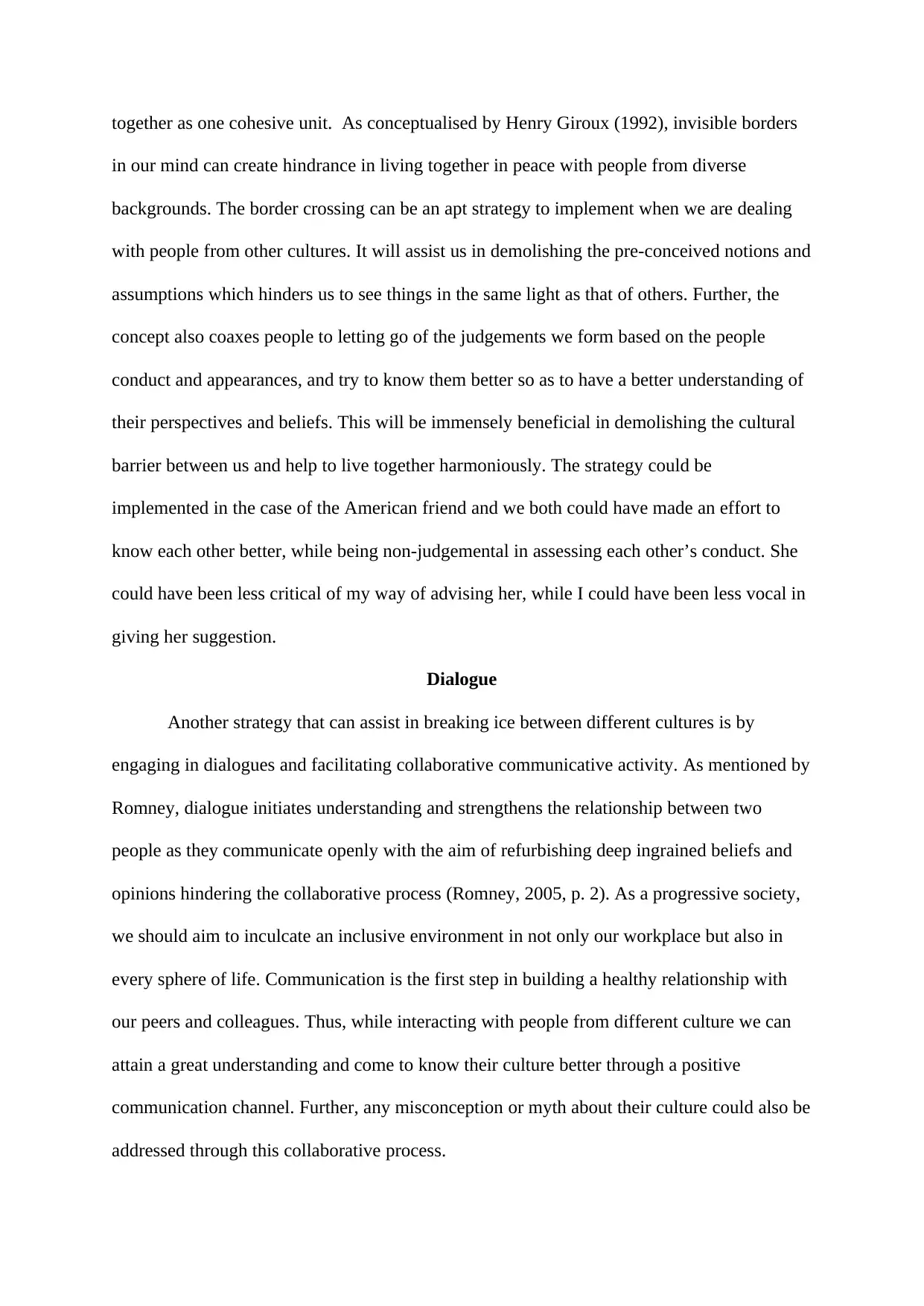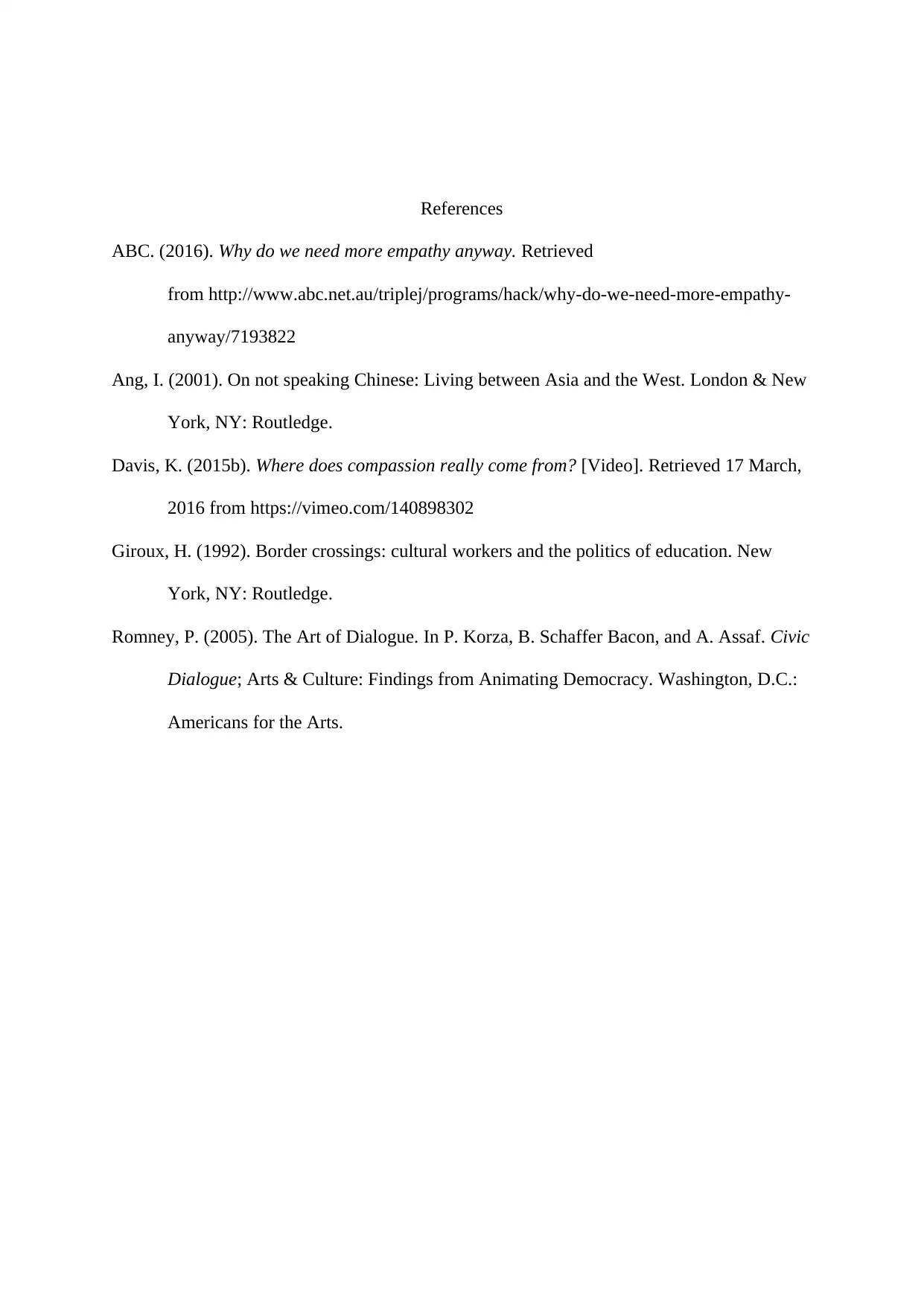Reflective Journal: Cultural Diversity in a Multicultural World
VerifiedAdded on 2022/09/21
|4
|1198
|53
Journal and Reflective Writing
AI Summary
This reflective journal explores the complexities of cultural amalgamation in a globalized world. The author reflects on personal experiences and the challenges of cultural differences, particularly in the context of border crossings and intercultural communication. Drawing on concepts from Ien Ang, Henry Giroux, and others, the journal proposes strategies for fostering harmonious living, including border crossing, dialogue, and the cultivation of empathy and compassion. The journal highlights the importance of understanding different cultural perspectives and the need for inclusive environments in both professional and personal settings. The author emphasizes the role of communication in breaking down cultural barriers and building positive relationships, ultimately advocating for a more empathetic and cooperative approach to living in a diverse world. References to relevant academic sources are included to support the reflection.

Reflective Journal
The reflective journal aims to put forth my reflection about the ways cultural
amalgamation can take place in the world. The reflective journal deals with the topic and
provides a practical approach to it. Further, through this paper I am also going to suggest
certain strategies which could be implemented while staying together with people of varied
backgrounds and culture.
Cultural Differences
As the world is becoming more integrated with the borders melting, and the people
from various culture coming together in a common platform for both professional as well
personal objectives, the differences in their lifestyle and approach is becoming more evident.
The advent of globalisation requires us to amalgamate our differences and work towards a
common approach. As proposed by Ien Ang’s (2001), the simpler it may sound, the more
complex is the process. People come with their own interpretation and perspective to things
which are often fuelled by the way they were brought up or the norms prevalent in their
culture. I used to think United States as a culture which has acceptance to people coming
from varied background, but got a shock when I became friendly to an American who
recently shifted her base to Australia. As Australians, we are direct in our conversation and
tend to be less diplomatic or politically correct. However, the same thing was misconstrued
when I told the friend on her face that her elocution skills needs to be improved to score high
in debates. The friend got offended and told me that I am being rude. I did not want to offend
her in any way and felt that the interpretation of my words were done as per her culture and
norms, which is otherwise quite normal in Australia.
Border Crossing
As more and more people cross the borders and live in other countries for their
professional commitments, it has become necessary to forget the differences and work
The reflective journal aims to put forth my reflection about the ways cultural
amalgamation can take place in the world. The reflective journal deals with the topic and
provides a practical approach to it. Further, through this paper I am also going to suggest
certain strategies which could be implemented while staying together with people of varied
backgrounds and culture.
Cultural Differences
As the world is becoming more integrated with the borders melting, and the people
from various culture coming together in a common platform for both professional as well
personal objectives, the differences in their lifestyle and approach is becoming more evident.
The advent of globalisation requires us to amalgamate our differences and work towards a
common approach. As proposed by Ien Ang’s (2001), the simpler it may sound, the more
complex is the process. People come with their own interpretation and perspective to things
which are often fuelled by the way they were brought up or the norms prevalent in their
culture. I used to think United States as a culture which has acceptance to people coming
from varied background, but got a shock when I became friendly to an American who
recently shifted her base to Australia. As Australians, we are direct in our conversation and
tend to be less diplomatic or politically correct. However, the same thing was misconstrued
when I told the friend on her face that her elocution skills needs to be improved to score high
in debates. The friend got offended and told me that I am being rude. I did not want to offend
her in any way and felt that the interpretation of my words were done as per her culture and
norms, which is otherwise quite normal in Australia.
Border Crossing
As more and more people cross the borders and live in other countries for their
professional commitments, it has become necessary to forget the differences and work
Paraphrase This Document
Need a fresh take? Get an instant paraphrase of this document with our AI Paraphraser

together as one cohesive unit. As conceptualised by Henry Giroux (1992), invisible borders
in our mind can create hindrance in living together in peace with people from diverse
backgrounds. The border crossing can be an apt strategy to implement when we are dealing
with people from other cultures. It will assist us in demolishing the pre-conceived notions and
assumptions which hinders us to see things in the same light as that of others. Further, the
concept also coaxes people to letting go of the judgements we form based on the people
conduct and appearances, and try to know them better so as to have a better understanding of
their perspectives and beliefs. This will be immensely beneficial in demolishing the cultural
barrier between us and help to live together harmoniously. The strategy could be
implemented in the case of the American friend and we both could have made an effort to
know each other better, while being non-judgemental in assessing each other’s conduct. She
could have been less critical of my way of advising her, while I could have been less vocal in
giving her suggestion.
Dialogue
Another strategy that can assist in breaking ice between different cultures is by
engaging in dialogues and facilitating collaborative communicative activity. As mentioned by
Romney, dialogue initiates understanding and strengthens the relationship between two
people as they communicate openly with the aim of refurbishing deep ingrained beliefs and
opinions hindering the collaborative process (Romney, 2005, p. 2). As a progressive society,
we should aim to inculcate an inclusive environment in not only our workplace but also in
every sphere of life. Communication is the first step in building a healthy relationship with
our peers and colleagues. Thus, while interacting with people from different culture we can
attain a great understanding and come to know their culture better through a positive
communication channel. Further, any misconception or myth about their culture could also be
addressed through this collaborative process.
in our mind can create hindrance in living together in peace with people from diverse
backgrounds. The border crossing can be an apt strategy to implement when we are dealing
with people from other cultures. It will assist us in demolishing the pre-conceived notions and
assumptions which hinders us to see things in the same light as that of others. Further, the
concept also coaxes people to letting go of the judgements we form based on the people
conduct and appearances, and try to know them better so as to have a better understanding of
their perspectives and beliefs. This will be immensely beneficial in demolishing the cultural
barrier between us and help to live together harmoniously. The strategy could be
implemented in the case of the American friend and we both could have made an effort to
know each other better, while being non-judgemental in assessing each other’s conduct. She
could have been less critical of my way of advising her, while I could have been less vocal in
giving her suggestion.
Dialogue
Another strategy that can assist in breaking ice between different cultures is by
engaging in dialogues and facilitating collaborative communicative activity. As mentioned by
Romney, dialogue initiates understanding and strengthens the relationship between two
people as they communicate openly with the aim of refurbishing deep ingrained beliefs and
opinions hindering the collaborative process (Romney, 2005, p. 2). As a progressive society,
we should aim to inculcate an inclusive environment in not only our workplace but also in
every sphere of life. Communication is the first step in building a healthy relationship with
our peers and colleagues. Thus, while interacting with people from different culture we can
attain a great understanding and come to know their culture better through a positive
communication channel. Further, any misconception or myth about their culture could also be
addressed through this collaborative process.

The future professional place that I will be working is going to be influx with people
coming from varied background, and to facilitate a healthy work environment I need to be
prepared of the cultural differences amongst us. In such scenario, adopting a positive
dialogue intended to border crossing is the best strategy that can be initiated to ward of any
cultural barriers. The cultural barriers could be a hindrance in accomplishing the common
objectives of the department or organisation. Any ignorance or misconception should be
addressed in the communication and any differences sorted out at the earliest. With these
steps in hand, I am sure there will not be any scope of cultural conflict. Such an environment
is conducive for the healthy working of an organisation.
Empathy and Compassion
The module was also instrumental in making me understand the power of empathy
and understand the difficulty and emotions the other person is feeling. While empathising, I
am thinking from the same shoes of the other person and understand his or her perspective. It
helps me understand what he or she is going through and perceive the world from the same
lens as the other person. The module also explained the difference in sympathy and empathy,
and why I should strive to adopt empathy and not merely sympathize with people. Empathy
tends to minimize the differences and facilitate an environment conducive to compassion for
the people from other culture (ABC, 2016). The videos were also a great help in
understanding how to possess a mindfulness all the time so as to see people in a different
light, as to their real self (Davis, 2015b). Such an approach not only makes the world a better
place to live but also facilitates a cooperative relationship amongst those around us. With the
help of these elements people will also be able to achieve the goals they have set for
themselves and progress the society as a whole.
coming from varied background, and to facilitate a healthy work environment I need to be
prepared of the cultural differences amongst us. In such scenario, adopting a positive
dialogue intended to border crossing is the best strategy that can be initiated to ward of any
cultural barriers. The cultural barriers could be a hindrance in accomplishing the common
objectives of the department or organisation. Any ignorance or misconception should be
addressed in the communication and any differences sorted out at the earliest. With these
steps in hand, I am sure there will not be any scope of cultural conflict. Such an environment
is conducive for the healthy working of an organisation.
Empathy and Compassion
The module was also instrumental in making me understand the power of empathy
and understand the difficulty and emotions the other person is feeling. While empathising, I
am thinking from the same shoes of the other person and understand his or her perspective. It
helps me understand what he or she is going through and perceive the world from the same
lens as the other person. The module also explained the difference in sympathy and empathy,
and why I should strive to adopt empathy and not merely sympathize with people. Empathy
tends to minimize the differences and facilitate an environment conducive to compassion for
the people from other culture (ABC, 2016). The videos were also a great help in
understanding how to possess a mindfulness all the time so as to see people in a different
light, as to their real self (Davis, 2015b). Such an approach not only makes the world a better
place to live but also facilitates a cooperative relationship amongst those around us. With the
help of these elements people will also be able to achieve the goals they have set for
themselves and progress the society as a whole.
⊘ This is a preview!⊘
Do you want full access?
Subscribe today to unlock all pages.

Trusted by 1+ million students worldwide

References
ABC. (2016). Why do we need more empathy anyway. Retrieved
from http://www.abc.net.au/triplej/programs/hack/why-do-we-need-more-empathy-
anyway/7193822
Ang, I. (2001). On not speaking Chinese: Living between Asia and the West. London & New
York, NY: Routledge.
Davis, K. (2015b). Where does compassion really come from? [Video]. Retrieved 17 March,
2016 from https://vimeo.com/140898302
Giroux, H. (1992). Border crossings: cultural workers and the politics of education. New
York, NY: Routledge.
Romney, P. (2005). The Art of Dialogue. In P. Korza, B. Schaffer Bacon, and A. Assaf. Civic
Dialogue; Arts & Culture: Findings from Animating Democracy. Washington, D.C.:
Americans for the Arts.
ABC. (2016). Why do we need more empathy anyway. Retrieved
from http://www.abc.net.au/triplej/programs/hack/why-do-we-need-more-empathy-
anyway/7193822
Ang, I. (2001). On not speaking Chinese: Living between Asia and the West. London & New
York, NY: Routledge.
Davis, K. (2015b). Where does compassion really come from? [Video]. Retrieved 17 March,
2016 from https://vimeo.com/140898302
Giroux, H. (1992). Border crossings: cultural workers and the politics of education. New
York, NY: Routledge.
Romney, P. (2005). The Art of Dialogue. In P. Korza, B. Schaffer Bacon, and A. Assaf. Civic
Dialogue; Arts & Culture: Findings from Animating Democracy. Washington, D.C.:
Americans for the Arts.
1 out of 4
Related Documents
Your All-in-One AI-Powered Toolkit for Academic Success.
+13062052269
info@desklib.com
Available 24*7 on WhatsApp / Email
![[object Object]](/_next/static/media/star-bottom.7253800d.svg)
Unlock your academic potential
Copyright © 2020–2025 A2Z Services. All Rights Reserved. Developed and managed by ZUCOL.





